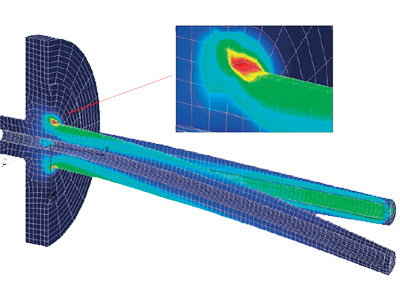RTD, TC, ThermoWell
There is technology for manufacturing most of the temperature equipment in the country. These equipments include:
- Temperature sensors of RTD and thermocouple types
- Sensors with long and different lengths
- Different types of thermocouple
- Ceramic thermowell
There is the ability to supply and manufacture all the above-mentioned equipment for the company. Considering the time required for design, client approval, material preparation and manufacturing, the delivery time of the equipment will be approximately one month after ordering.
A brief description of each equipment can be found below.
Thermocouple
Thermocouple consists of two metals from different type that are interconnected on one side. If the junction point of two metals is heated, the potential difference is generated on the other two free ends. This potential difference is a function of the amount of heat applied, and therefore the temperature applied to the thermocouple can be detected by examining the output voltage.
It consists of two metals from different type such as iron and Constantine which are electrically connected to one another and form a hot junction or sensing element at the connection point. Temperature measuring is carried out at this hot junction which is in contact with the process. Although this is called a hot junction, a thermocouple may also be used to measure temperatures below zero and a hot junction may be set at such a temperature. Applying heat to the junction of two metals at a hot junction creates a small voltage between the two metals on the other side. A cold or reference junction is formed at this point which is directly connected to a transmitter or voltmeter.
The relationship between the output voltage and temperature is not linear. According to the obtained voltage value, the process temperature is acquired by reading from a curve or through thermocouple tables. In the thermocouple tables, the different voltages associated with each temperature are listed. For each type of thermocouple, a table is required. In microprocessor-based equipment, the conversion procedure is based on the information stored in the equipment.
The thermocouple is a self-generating transducer consisting of two or more junctions between metals with different materials. The thermocouples are divided into two separate groups. These two groups are known as base metal thermocouples and novel metal thermocouples.
The major advantage of thermocouples is their wide range of measurement, which typically ranges from -180 to +1800 degrees Celsius.
If a small part of the welded tip of the thermocouple is removed and the thermocouple is inserted into the pipeline, the temperature of the flowing fluid inside the pipe can be measured without any hassle. This is the basic concept for manufacturing the thermocouple temperature sensor.
Thermocouples have different types for temperature measurements, for example R-S-B and L-K-J types have the ability to measure temperature at different temperature ranges.
Thermocouples are used to measure high temperatures (e.g in furnaces). The measured temperatures by the thermocouples at low temperatures are generally not very accurate, but they are best candidates for measuring temperatures above 500 degrees Celsius.
RTD Sensor
RTD is the abbreviation for Resistance Temperature Sensor which includes a resistance in a way that its value changes based on temperature variations.
The most used element in RTD is a wire wrapped around a ceramic or glass core. This element is usually very fragile so it is placed in a protective sheath. The RTD element is manufactured from pure materials whose resistance at various temperatures is fully documented. For this reason, the sensor has a predictable resistance change depending on its temperature which this predictability makes it possible to measure its temperature.
The RTD sensors are one of most accurate thermal sensors available. These sensors are excellent not only in accuracy but also in stability and repeatability. These sensors are also relatively resistant to electrical disturbances (electrical noise) and are therefore widely used in industrial environments, especially alongside motors, generators and other high voltage devices.
Thermowell
Thermowell is a device used to protect the temperature sensor against potential process-related damage (mechanical stress, corrosion, etc.). The connection of the thermowell to the tank or pipe can be as threaded, flange or weld types. The thermowell pipe can also be made of bar stock, pipe or tubular.
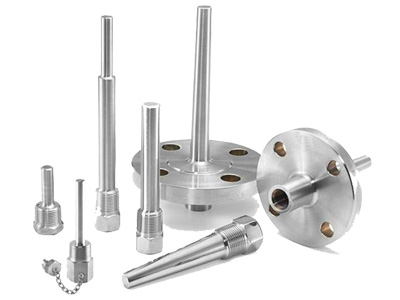
The length of the thermowell from which it enters into the tube or tank (the length between the connection and the end of the thermowell) is called the insertion length and denoted by U. In addition, the length of the thermowell that lies outside the tank or tube is called extension length and denoted by T.
The value for the insertion length must be selected in such a way that it is always in contact with the fluid in order to measure the temperature with minimum error. This value is usually chosen so that the end of the thermowell is placed in the middle third of the tube.
Thermowells are divided into three categories in terms of structure; straight, tapered, and stepped.
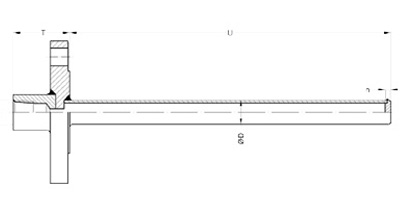
The advantage of the straight type thermowell is their cheapness due to using pipes or tubes in their structures instead of metal bars. The mechanical strength of these thermowells is relatively low and can only be used in processes with low pressure and flow.
It is preferable to choose tapered thermowell when the insertion length is long or there is a vibration in the process.
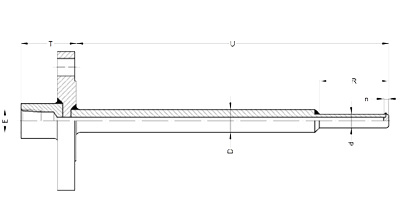
The stepped thermowell as seen from their structure becomes very thin at the bottom to be able to transfer the temperature with the minimum drop and also in the shortest possible time (response time).
Since the thermowell is placed as a barrier in the fluid path, the fluid encounters turbulence and agitation after colliding with the thermowell.
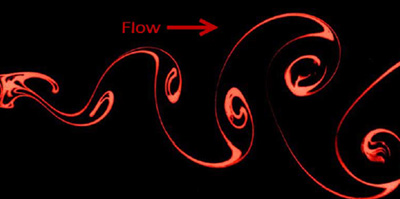
If the frequency of these produced waves is equal to the resonant frequency of the thermowell structure, it will cause vibration and mechanical stress on it and may lead to cracks and fractures. Therefore, in order to avoid this, Wake Frequency calculations must be done before construction. The calculations are usually performed according to ASME PTC 19.3.
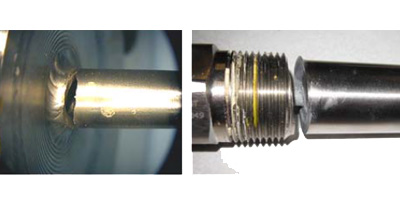
Another important point is the choice of the appropriate material for thermowell construction, which is determined by the type of fluid, corrosion, abrasion, and its temperature.
